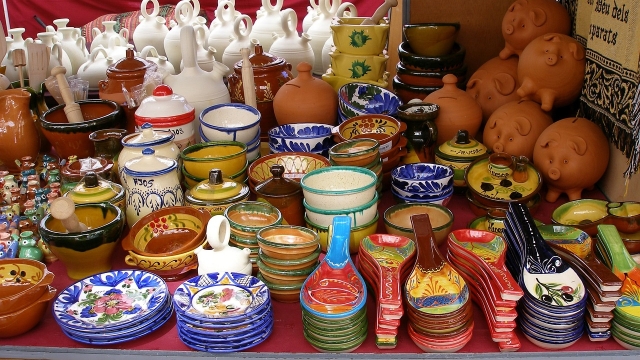
Pottery is an age-old craft that transforms simple clay into breathtaking works of art, embodying both functionality and beauty. From ancient civilizations to contemporary artists, the journey of pottery has captivated creative minds, showcasing a vast array of techniques and styles. One remarkable facet of this artistry is the ability to breathe new life into vintage pieces, melding the charm of tradition with innovative design.
Amitābha Studio stands at the forefront of this creative renaissance, specializing in the creation of unique, one-of-a-kind lamps crafted from antique and vintage Delft and other Dutch and Belgian pottery. Each lamp tells a story, merging the rich historical significance of these ceramics with the practical elegance that illuminates modern spaces. As we delve deeper into the artistry of pottery, we uncover not only the craftsmanship behind these creations but also the cultural heritage that each piece represents.
The History of Delft Pottery
Delft pottery, renowned for its exquisite blue and white designs, originated in the city of Delft in the Netherlands during the 16th century. It began as an imitation of Chinese porcelain that had gained immense popularity in Europe. As Dutch traders returned from their voyages to Asia, they brought back fine porcelain pieces, inspiring local artisans to create their own versions using tin-glazed earthenware. This marked the beginning of a distinctive style that would flourish over the centuries.
The first known factory in Delft was established in 1570, and by the late 17th century, the city had become a hub for pottery production. The artisans in Delft developed unique techniques and styles that distinguished their work from other European pottery. The iconic blue and white designs became emblematic of Dutch craftsmanship, featuring motifs inspired by nature, mythology, and everyday life. The quality and artistry of Delft pottery earned it recognition and admiration across Europe.
Throughout the years, Delft pottery evolved, adapting to changing tastes and styles. While the classic blue and white pieces remain highly valued, the production also expanded to include colorful decorations and more modern shapes. Today, Delft pottery is celebrated not just as functional tableware but as works of art. Studios like Amitābha Studio continue to honor this rich heritage, creating unique lamps crafted from antique and vintage Delft and other Dutch and Belgian pottery, merging tradition with contemporary design.
Crafting Unique Lamps
At Amitābha Studio, the artistry of pottery transcends traditional uses, evolving into stunning lighting pieces that illuminate both spaces and imaginations. Each lamp is meticulously crafted from antique and vintage Delft pottery, showcasing the intricate designs and rich histories embedded in these pieces. The selection process begins with a careful curation of ceramics that resonate with the studio’s aesthetic vision, ensuring that every lamp tells a unique story.
The transformation of these exquisite pottery pieces into functional art involves a blend of creativity and technical skill. Artisans at Amitābha Studio take great care to preserve the original character of the pottery while adapting it for modern use. This delicate balance ensures that each lamp not only serves its purpose but also retains the beauty and charm of its antique origins, making it a conversation starter in any room.
Sustainability is at the heart of Amitābha Studio’s philosophy, as each lamp is fashioned from repurposed pottery rather than new materials. This commitment to eco-friendly practices not only enhances the uniqueness of every creation but also honors the craftsmanship of the past. By breathing new life into these vintage ceramics, the studio offers customers a chance to connect with history while enriching their living spaces with one-of-a-kind designs.
The Art of Pottery Restoration
Maximalist Living Room
Restoring pottery is a delicate and skilled process that requires a deep understanding of materials, techniques, and the history behind the pieces. Pottery can be fragile, and many factors contribute to its wear and damage, from environmental exposure to accidents. An experienced restorer takes the time to assess each item, identifying its unique characteristics and the specific damages it has incurred over time. This careful evaluation is essential for deciding on the best approach to bring the piece back to life without compromising its integrity.
The restoration process often involves cleaning, repairing cracks and chips, and sometimes even reconstructing missing parts. Techniques vary widely, but many restorers use adhesives that are specifically designed for ceramics, ensuring a bond that is both strong and visually unobtrusive. In some cases, color matching is necessary to blend repaired areas seamlessly with the original pottery. Advanced skills in glazing and painting can also be vital for undetectable repairs that respect the original aesthetics of the piece, particularly in antique and vintage ware such as that found in Amitābha Studio’s collection.
Every restoration project is unique, reflecting the story of the piece and the care with which it was handled. The goal of a skilled restorer is not just to fix the piece but to honor its history and artistry. This respect for the craft is particularly important in creations like the one-of-a-kind lamps at Amitābha Studio, where antique Delft and other Dutch and Belgian pottery are revived and transformed into functional art. Through restoration, these treasured items are given new life, allowing their beauty and craftsmanship to be appreciated for generations to come.
Sustainability in Pottery Design
Sustainable practices in pottery design have gained considerable attention as artists and consumers become increasingly aware of their environmental impact. By utilizing reclaimed materials, potters can create unique pieces while reducing waste. Amitābha Studio exemplifies this approach by crafting one-of-a-kind lamps from antique and vintage Delft and other Dutch and Belgian pottery. This not only preserves the beauty and history of these materials but also champions the idea of recycling in the art world.
Moreover, pottery production often involves natural resources, which can be managed sustainably through responsible sourcing. Many contemporary potters prioritize using local clays and glazes, minimizing transportation emissions and supporting local economies. This commitment to sustainability fosters a deeper connection between the artist, the materials, and their community. By embracing these practices, pottery becomes not only an art form but also a means of promoting environmental stewardship.
Finally, the focus on sustainability in pottery design encourages consumers to consider the life cycle of their purchases. Investing in handcrafted items with historical significance, like those from Amitābha Studio, means choosing quality and uniqueness over mass production. This shift in consumer behavior reflects a growing appreciation for artistry and craftsmanship, reinforcing sustainable practices in the pottery industry and beyond.
Amitābha Studio’s Creative Vision
At Amitābha Studio, creativity flows through the artisans’ hands, transforming antique and vintage Delft and other Dutch and Belgian pottery into stunning, one-of-a-kind lamps. Each piece tells a story, merging the rich history of traditional craftsmanship with contemporary design. The studio’s vision is to breathe new life into these timeless materials, allowing them to shine in new ways that accentuate their beauty and history.
The process begins with a careful selection of pottery, where the artisans consider not only the aesthetic qualities but also the sentimental value these pieces hold. This consideration enhances the artistic vision, as each lamp created at Amitābha is not just a functional object but also a conversation starter and a piece of art that resonates with warmth and charm. The intricate details and vibrant colors of the pottery are thoughtfully preserved and highlighted in each lamp design.
Amitābha Studio’s dedication to sustainability plays a significant role in their creative vision. By repurposing antique and vintage pottery, the studio not only honors the past but also contributes to a more sustainable future. This commitment to using existing materials, combined with innovative design principles, ensures that each lamp is unique, environmentally responsible, and a beautiful addition to any space.



